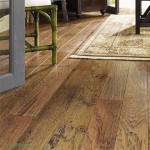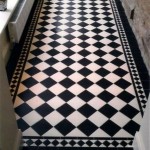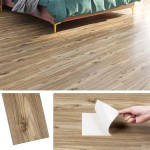The Enduring Appeal of Wide Plank White Oak Flooring
Wide plank white oak flooring has experienced a surge in popularity in recent years, moving beyond a niche aesthetic to become a coveted design element in both residential and commercial spaces. The allure lies in a combination of factors, including the inherent beauty of the wood itself, the visual impact of the wider planks, and the perceived increase in value and character that this type of flooring brings to a property. Understanding the nuances of wide plank white oak, from its sourcing and grading to its installation and maintenance, is crucial for making informed decisions when considering this flooring option.
White oak, scientifically classified as *Quercus alba*, is a hardwood species native to eastern and central North America. It is known for its durability, strength, and resistance to decay and moisture, making it a suitable choice for flooring applications. The closed-grain structure of white oak contributes to its water resistance, a characteristic that sets it apart from red oak. This resistance is due to the presence of tyloses, cellular outgrowths that block the water-conducting vessels within the wood. As a result, white oak is frequently used in shipbuilding, cooperage (barrel making), and, of course, flooring, where exposure to moisture is a potential concern. The color of white oak ranges from light tan to pale yellow-brown, offering a versatile backdrop for various staining and finishing options.
The distinction of "wide plank" typically refers to planks that are significantly wider than the standard 2 1/4" or 3 1/4" strips commonly found in traditional hardwood flooring. While there is no universally agreed-upon definition of "wide," planks generally considered to be in the wide plank category start at around 5 inches in width and can extend to 12 inches or even wider. This increased width creates a different visual effect, showcasing more of the natural grain pattern and reducing the number of seams on the floor surface. The fewer seams contribute to a more spacious and less busy appearance, which is highly desirable in contemporary designs.
Aesthetic and Visual Impact of Wide Plank Flooring
The most immediate benefit of wide plank white oak flooring is its aesthetic appeal. The wider boards reveal more of the wood's natural character, including variations in grain, knots, and color. This highlights the inherent beauty of the material and creates a more visually engaging surface. Compared to narrower strips, wide planks offer a more unified and expansive look, making rooms appear larger and less fragmented. This is particularly beneficial in smaller spaces, where the illusion of greater size can be significantly enhanced. The visual continuity achieved with wide planks minimizes distractions and promotes a sense of flow and harmony within the room.
Furthermore, wide plank flooring allows for a greater appreciation of the wood's texture. The larger surface area of each plank provides more opportunity to showcase the subtle variations in the wood's surface, such as saw marks or hand-scraped textures. These details add depth and character, creating a floor that feels both authentic and luxurious. The tactile experience of walking on a wide plank floor is also enhanced, as the wider boards provide a more substantial and stable platform underfoot. This contributes to an overall sense of quality and comfort.
The choice of stain and finish can further enhance the aesthetic impact of wide plank white oak flooring. White oak readily accepts a wide range of stains, from light and natural tones to dark and dramatic hues. A clear finish will highlight the natural color and grain of the wood, while a stain can be used to create a specific mood or complement the existing décor. Matte finishes are particularly popular for wide plank floors, as they minimize glare and create a more natural and understated look. The combination of wide planks, a carefully chosen stain, and a matte finish can result in a floor that is both visually stunning and timelessly elegant.
Structural Considerations and Installation
While the aesthetic advantages of wide plank white oak flooring are undeniable, it is essential to consider the structural implications of using wider boards. Wood is a hygroscopic material, meaning that it expands and contracts in response to changes in humidity. Wider planks are more susceptible to movement than narrower strips, as the expansion and contraction occur across a greater surface area. This can lead to issues such as cupping (where the edges of the planks rise), gapping (where spaces appear between the planks), or even warping if the wood is not properly acclimated or installed.
To mitigate these risks, it is crucial to ensure that the wood is properly dried and acclimated to the environment in which it will be installed. Acclimation involves allowing the wood to adjust to the temperature and humidity levels of the room for a period of several days or even weeks before installation. This allows the wood to reach its equilibrium moisture content (EMC), which is the point at which it is in balance with the surrounding environment. Proper acclimation minimizes the likelihood of excessive movement after installation.
The installation method is also critical for ensuring the long-term stability of wide plank flooring. Solid hardwood flooring is typically nailed or glued down to the subfloor, while engineered hardwood flooring can be floated, glued, or nailed. For wide plank floors, gluing or nailing is generally recommended, as these methods provide the most secure attachment and minimize movement. In some cases, a combination of gluing and nailing may be used for added stability. It is essential to use high-quality adhesives and fasteners that are specifically designed for hardwood flooring to ensure a strong and lasting bond.
The subfloor itself must also be properly prepared before installation. The subfloor should be level, clean, and dry to provide a solid and stable base for the flooring. Any imperfections or irregularities in the subfloor should be corrected before installation to prevent unevenness or creaking in the finished floor. A moisture barrier may also be installed beneath the flooring to protect it from moisture damage. Consulting with a professional flooring installer is highly recommended to ensure that the installation is done correctly and that the flooring will perform well over time.
Maintenance and Long-Term Durability
Wide plank white oak flooring is known for its durability, but proper maintenance is essential for preserving its beauty and extending its lifespan. Regular cleaning is necessary to remove dirt, dust, and debris that can scratch or dull the finish. Sweeping, vacuuming, or using a dust mop are all effective methods for removing loose particles. When cleaning with water, it is important to use a damp mop rather than a wet mop, as excessive moisture can damage the wood. Specialized hardwood floor cleaners are available and should be used according to the manufacturer's instructions.
Preventative measures can also help to protect the flooring from damage. Placing mats at entrances can trap dirt and moisture before they are tracked onto the floor. Using felt pads under furniture legs can prevent scratches and dents. Avoiding high heels and other sharp objects can also help to minimize damage. It is also important to control humidity levels within the home, as excessive fluctuations in humidity can cause the wood to expand and contract, leading to cupping or gapping.
The finish on the flooring is the primary barrier against wear and tear. Over time, the finish will inevitably wear down, particularly in high-traffic areas. When the finish becomes noticeably worn, it may be necessary to refinish the floor. Refinishing involves sanding down the old finish and applying a new coat of finish. This can restore the floor to its original beauty and protect it from further damage. The frequency of refinishing will depend on the amount of traffic and the type of finish used. With proper care and maintenance, wide plank white oak flooring can last for generations, adding value and character to a home for years to come.
In conclusion, the enduring appeal of wide plank white oak flooring stems from its combination of aesthetic beauty, structural integrity, and long-term durability. By understanding the nuances of this flooring option and taking appropriate steps to ensure its proper installation and maintenance, homeowners can enjoy the benefits of a beautiful and lasting floor for many years.

Grand Width 9 5in White Oak Engineered Hardwood Flooring

White Oak Hardwood Flooring Vermont Wide Plank

Euro White Oak Wide Plank Engineered Hardwood Floo

Engineered Hard Wood Floors Oak Stonewoodproducts Com

Carolina

Wide Plank White Oak Flooring Mill Direct Usa Made

Rift And Quartersawn White Oak It S A Grain Thing Carlisle Wide Plank Floors
Nothing But White Oak Mannington

Hardwood Champagne Rustic European White Oak Floor Art Wide Plank Coll Factory Flooring Liquidators

Sunset 9 1 2 Wide White Oak Engineered Hardwood Flooring







